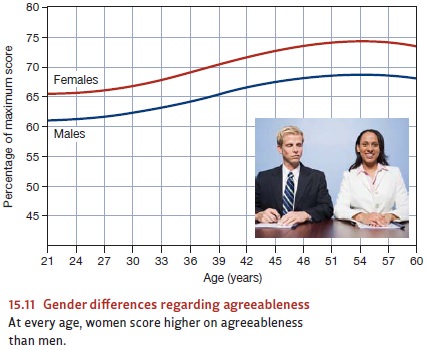Chapter: Psychology: Personality
The Trait Approach: Traits and the Environment
Traits and the Environment
It
seems plausible, then, that genes influence personality in a variety of ways—by
deter-mining the reactivity of neurotransmitter systems, the threshold for
activation in the amygdala, and more. But, as we have repeatedly noted, genetic
influence will emerge only if certain environmental supports are in place. In
addition, virtually any character-istic shaped by the genes is also likely to
be shaped by environmental factors. What are the environmental factors relevant
to the development of someone’s personality? Three sources of influence have
been widely discussed: cultures, families, and differences among members within
the same family.
CULTURAL EFFECTS
As
we have seen, the evidence is mixed on whether the Big Five dimensions are as
useful for describing personalities in Korea as they are in Kansas, as useful
in Niger as they are in Newport. But no matter what we make of this point, we
need to remember that the Big Five is simply a framework for describing how
people differ; if the framework is in fact universal, this simply tells us that
we can describe personalities in different cultures using the same (universal)
measuring system, just as we can measure objects of different sizes using the
same ruler. This still leaves open, however, what the personalities are in any
given culture—that is, what we will learn when we use our measuring system.
Scholars
have long suggested that people in different cultures have different
personalities—so that we can speak of a “German personality,” or a “typical
Italian,” and so on. One might fear that these suggestions amount to little
beyond stereotyping, and indeed, some scholars have argued that these
perceptions may be entirely illusory (McCrae & Terracciano, 2006). Mounting
evidence suggests, however, that there is a kernel of truth in some of these
claims about national character. For
example, one study has shown that there are differences from one country to the
next in how consci-entious people seem to be. These differences are manifest in
such diverse measures as pedestrians’ walking speed, postal workers’
efficiency, accuracy of public clocks, and even longevity in each of these
countries (Heine, Buchtel, & Norenzayan, 2008)!
Where
might these cultural differences in personality come from? One long-standing
hypothesis is that the key lies in how a group of people sustains itself,
whether through farming or hunting or trade (Barry, Child, & Bacon, 1959;
Hofstede, 2001; Maccoby, 2000). More recent models, in contrast, take a more
complex view, and sug-gest that cultural differences in personality—whether
between nations or across regions within a single nation—arise via a
combination of forces (Jokela, Elovainio, Kivimaki, & Keltikangas-Jarvinen,
2008; Rentfrow, Gosling, & Potter, 2008). These forces include historical
migration patterns, social influence, and environmental factors that
dynamically reinforce one another over time. To make this concrete, let’s
consider immigrants who first make their way to a new geographical region
(whether fleeing persecution or seeking prosperity). It seems unlikely that
these trailblazers will be a ran-dom sample of the larger population. Instead,
the mere fact that they decided to relo-cate suggests that they may be willing
to take risks and more open to new experiences in comparison to others who were
not willing to emigrate. This initial difference might then be magnified via
social influence—perhaps because the especially extraverted or open individuals
engaged in practices that shaped the thoughts, feelings, and behaviors of those
around them.
Arguments
like these may help us understand why different regions within the United
States often seem characterized by distinct personality types, with neuroticism
especially common in some of the mid-Atlantic states and openness to new
experience

common
in the Pacific Northwest. Indeed, one recent book (Florida, 2008) urges people
to seek out regions that have personalities compat-ible with their
own—providing yet another factor shaping regional or national personality:
People may move to an area because they believe (or hope) certain traits are
common there, and this selective migration can itself create or magnify
regional differences (Figure 15.9).
FAMILY EFFECTS
It
seems likely that another factor shaping personality is one’s family. If the
family environment does influence personality, we would expect a
A
similar message emerges from a study that compared the personality traits of
pairs of adult twins. Some of the twins had been reared within the same family;
others had been reared apart and had been separated for an average of over 30
years. Among the twins reared together the personality scores for identical
twins were, as usual, more highly correlated than the scores of fraternal twins,
with correlations of .51 and .23, respectively. Thus, greater genetic
resemblance (identical twins, remember, share all of their genes; fraternal
twins share only half of their genes) led to greater personality resemblance.
Amazingly, though, the twins who were reared apart and had been separated for
many years showed nearly the same pattern of results as twins who grew up
together. The correlations were .50 and .21 for identical and fraternal twins,
respectively. (Moloney, Bouchard, & Segal, 1991).
One
might have expected the correlations to be considerably lower for the traits of
the twins who had been raised apart, since they were reared in different family
environ-ments. That the results were nearly the same whether the twins were
raised together or apart speaks against granting much importance to the various
environmental factors that make one family different from the next (Bouchard,
1984; Bouchard et al., 1990; Tellegen et al., 1988; also see Turkheimer &
Waldron, 2000).
Some
authors have drawn strong conclusions from these data—namely, that the family
plays little role in shaping personality (J. R. Harris, 1998). We would urge
cau-tion, though, in making this sweeping claim. Most of the available evidence
comes from families whose socioeconomic status was working class or above, and
this range is rather limited. It does not include the environments provided by
parents who are unemployed or those of parents who abuse or neglect their
children. If the range had been broadened to include more obviously different
environments, between-family environmental differences would surely have been
demonstrated to be more important (Scarr, 1987, 1992).
WITHIN
– FAMILY EFFECTS
If—within
the range of environments studied—between-family environmental differ-ences are
less important than one might expect, what environmental factors do mat-ter?
According to Plomin and Daniels (1987), the key lies in how the environments
vary for different children within the same family. To be sure, children within
a family

share
many aspects of their objective environment. They have the same parents, they
live in the same neighborhood, they have the same religion, and so on. But the
environments of children within a family also differ in crucial ways. They have
different friends, teach-ers, and peer groups, and these can play an important
role in shap-ing how they behave. Moreover, various accidents and illnesses can
befall one child but not another, with potentially large effects on their
subsequent personalities. Another difference concerns the birth order of each
child, since the family dynamic is different for the first-born than it is for
later-born children (Figure 15.10). Some authors have suggested that birth
order may have a powerful influ-ence on personality, with later-borns being
more rebellious and more open to new experiences than first-borns (Sulloway,
1996).
Factors
like these suggest that the family environment may matter in shaping
per-sonality, but they indicate that we need to focus on within-family
differences rather than between-family factors, like the fact that one family
is strict and another lenient, or the fact that some parents value education
while others value financial achievement. Indeed, within-family factors may be
especially important since parents often do what they can to encourage
differences among their children; some authors have suggested that this is a
useful strategy for diminishing sibling rivalry (Schachter, 1982).
The
gender of the child also plays a role. A brother and sister grow up in the same
household, but are likely to be treated differently by their parents (not to
mention other relatives, teachers, and friends). This, too, will provide a
family influence shaping person-ality (although obviously these gender effects
reach well beyond the family), but will once again produce within-family
contrasts. In any case, this sort of differential treatment for men and women
may—especially when combined with the biological differences between the
sexes—help us understand why women score higher on the “agreeableness”
dimension of the Big Five (Figure 15.11; Srivastava, John, Gosling, &
Potter, 2003), and why women are less likely to be sensation-seekers
(Zuckerman, 1994). In this context, though, we should also note that many of
the popular conceptions about gender differ-ences in personality—which are
surprisingly robust across cultures (Heine, 2008)—are probably overstated; in
fact, women and men appear remarkably similar, on average, on many aspects of
personality (Feingold, 1994; J. S. Hyde, 2005).

Related Topics